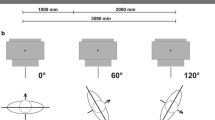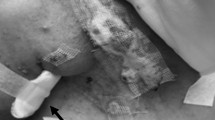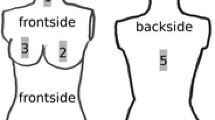Abstract
Skin dose assessment for radiotherapy patients is important to ensure that the dose received by skin is not excessive and does not cause skin reactions. Immobilizing casts may have a buildup effect, and can enhance the skin dose. This study has quantified changes to the surface dose as a result of head and neck immobilizing casts. Medtech and Renfu casts were stretched on the head of an Alderson Rando-Phantom. Irradiation was performed using 6 and 15 MV X-rays, and surface dose was measured by thermoluminescence dosimeters. In the case of 15MV photons, immobilizing casts had no effect on the surface dose. However, the mean surface dose increase reached up to 20 % when 6MV X-rays were applied. Radiation incidence angle, thickness, and meshed pattern of the casts affected the quantity of dose enhancement. For vertical beams, the surface dose increase was more than tangential beams, and when doses of the points under different areas of the casts were analysed separately, results showed that only doses of the points under the thick area had been changed. Doses of the points under the thin area and those within the holes were identical to the same points without immobilizing casts. Higher dose which was incurred due to application of immobilizing casts (20 %) would not affect the quality of life and treatment of patients whose head and neck are treated. Therefore, the benefits of head and neck thermoplastic casts are more than their detriments. However, producing thinner casts with larger holes may reduce the dose enhancement effect.

Similar content being viewed by others
References
Kelly A, Hardcastle N, Metcalfe P, Cutajar D, Quinn A, Foo K et al (2011) Surface dosimetry for breast radiotherapy in the presence of immobilization cast material. Phys Med Biol 56(4):1001–1013
Chiu-Tsao S-T, Chan MF (2010) Evaluation of two-dimensional bolus effect of immobilization/support devices on skin doses: a radiochromic EBT film dosimetry study in phantom. Med Phys 37:3611–3620
Heng Siew Ping, Sivamany Kandaiya Minimizing skin toxicity in intensity modulated radiotherapy of head and neck [http://www.researchgate.net/publication/237047156_MINIMIZING_SKIN_TOXICITY_IN_INTENSITY_MODULATED_RADIOTHERAPY_OF_HEAD_AND_NECK]. 2009
Kilic Ayhan KN, Ozkan L, Engin K (2001) The effects of various immobilization devices on buildup and surface doses. Turk onkologi Dergisi 16(4):179–182
De, Puysseleyr A D, Neve, W, De, Wagter, et al. The impact of an Orfit® patient positioning device on beam attenuation and buildup dose 2014.bhpa.eu/wp-content/uploads/…/De_Puysseleyr_Annemieke.pdf [cited 2014]
Bilge H, Yondem S, Kucucuk H, Cakir A, Meral R. Effects of immobilization beds on the dose in the entrance and exit dose region for Co-60, 4, 6 and 15 MV photons. Journal of BUON : official journal of the Balkan Union of Oncology. 2008 Jul-Sep;13(3):385–90. PubMed PMID: 18979554. Epub 2008/11/04. eng
Hadley SWKR, Lam K (2005) Effects of immobilization mask material on surface dose. J Appl Clin Med Phys 6(1):1–7
Fontenla DP, Napoli JJ, Hunt M, Fass D, McCormick B, Kutcher GJ (1994) Effects of beam modifiers and immobilization devices on the dose in the buildup region. Int J radiat oncol biol phys 30(1):211–219
Hsu SH, Roberson PL, Chen Y, Marsh RB, Pierce LJ, Moran JM (2008) Assessment of skin dose for breast chest wall radiotherapy as a function of bolus material. Phys Med Biol 53(10):2593–2606
Halm EA, Tamri A, Bridier A, Wibault P, Eschwege F (2002) Influence des masques thermoformes de contention sur la dose a la peau en radiotherapie des tumeurs des voies aerodigestives superieures fre (Influence of thermoplastic masks on the absorbed skin dose for head and neck tumor radiotherapy). Cancer radiotherapie : journal de la Societe francaise de radiotherapie oncologique 6(5):310–319
Lee N, Chuang C, Quivey JM, Phillips TL, Akazawa P, Verhey LJ, Xia P (2002) Skin toxicity due to intensity-modulated radiotherapy for head-and-neck carcinoma. Int J Radiat Oncol Biol Phys 53(3):630–637
Quach K, Morales J, Butson M, Rosenfeld AB, Metcalfe P (2000) Measurement of radiotherapy x-ray skin dose on a chest wall phantom. Med Phys 27:1676–1680
Rapley P (2006) Surface dose measurement using TLD powder extrapolation. Med Dosim 31(3):209–215
Khan FM. 2010. In: Physics of Radiation Therapy [http://www.amazon.com/Physics-Radiation-Therapy-Faiz-Khan-ebook/dp/B0050DHKNM]. Lippincott: Williams & Wilkins
Acknowledgments
The authors thank the office of Vice-President for Research of Mashhad University of Medical Sciences for funding this work. The authors are also grateful to Reza Radiation Oncology Center and Omid hospital for making use of linear accelerators possible.
Author information
Authors and Affiliations
Corresponding author
Rights and permissions
About this article
Cite this article
Soleymanifard, S., Toossi, M.T.B., Khosroabadi, M. et al. Assessment of skin dose modification caused by application of immobilizing cast in head and neck radiotherapy. Australas Phys Eng Sci Med 37, 535–540 (2014). https://doi.org/10.1007/s13246-014-0283-8
Received:
Accepted:
Published:
Issue Date:
DOI: https://doi.org/10.1007/s13246-014-0283-8




